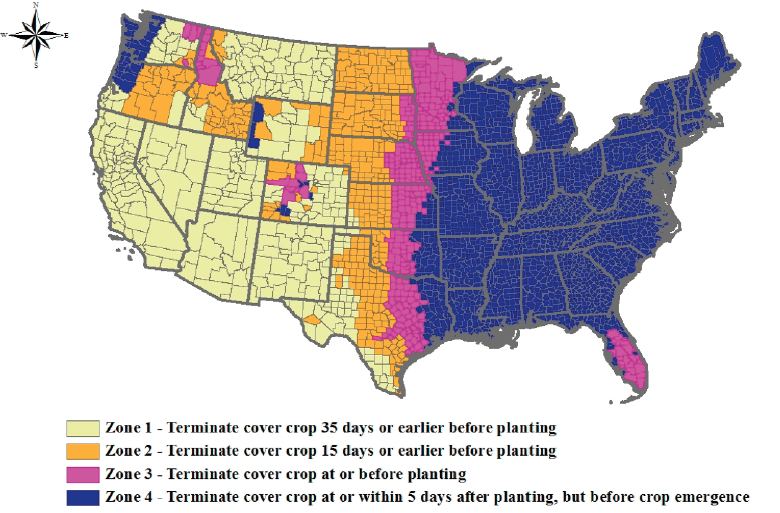Important questions about federal crop-insurance eligibility are still being discussed by USDA’s Risk Management Authority.
The Natural Resources Conservation Service (NRCS) has released new guidelines on the termination of cover crops that could answer a few uncertainties on how covers should be managed in different climates in the U.S.
The guidelines were issued this month after a USDA task force convened earlier this year to tackle contradictions among federal agencies on the use of cover crops — particularly as it pertains to crop insurance.
Even though these guidelines have been set, questions about eligibility for federal crop insurance must still be answered by the USDA's Risk Management Authority. The RMA will use the NRCS guidelines to decide if, and how, they will revise their policies on cover crops and crop insurance, says Ryan Stockwell, ag program manager for the National Wildlife Federation.
|
WORK THE ZONE. The cover-crop termination zones set by the NRCS in new guidelines released this month. The guidelines are meant to help different agencies at the USDA harmonize their policies on cover crop use. The RMA is still discussion how the new guidelines will affect the agency's policies on federal crop insurance. |
The NRCS says the guidelines were developed based on research literature, plant growth and soil hydrology models, and input from national and local experts in cover-crop management. The guidelines apply to non-irrigated cropland, including systems that contain a fallow period, and to cover crops actively growing at the time of termination.
|
To read a PDF file |
The agencies divided the U.S. into different zones that call for different timeframes for cover-crop termination. Zones 1 and 2 in the largely mountainous regions in the western U.S. were refined by NRCS and other local university experts to identify proper cover-crop management due to wide variability in climate and cropping systems.
These guidelines are a product of the USDA – Natural Resources Conservation Service (NRCS), Risk Management Agency (RMA), Farm Service Agency (FSA), and other public and private stakeholders.
“Recommendations are provided on termination periods to achieve conservation benefits and to minimize risk of yield reduction in the following crops because of the soil’s water use,” the NRCS says in its introduction.
The guidelines include 12 considerations for cover-crop termination, some of which are relevant to large numbers of no-tillers:
- If the cover crop is part of a no-till system, termination can be delayed up to 7 days from the termination-period guideline, but terminated prior to crop emergence.
- Where new technology has at least 3 years of satisfactory performance (achieves historical yield) based on farm records, and the written approval of two “agricultural experts” as defined by RMA, the cover crop may be terminated closer to planting, if recommended by the experts.
- Cover crops may be grazed as long as the planned amount of biomass is available at the time of termination. Cover crops that winterkill may be grazed to a level that meets their conservation purpose.
The guidelines also provide definitions of various cropping systems, including double-cropping, relay cropping and interplanting.
The new guidelines don’t indicate specific species of cover crops. Stockwell says there was concern on the task force of going into that level of detail considering the hundreds of combinations of covers and the infinite weather patterns in the U.S.
“The science is still not clear on cover-crop impact on moisture availability for the insured crop,” he notes. “We still need need more research on that.”





Post a comment
Report Abusive Comment